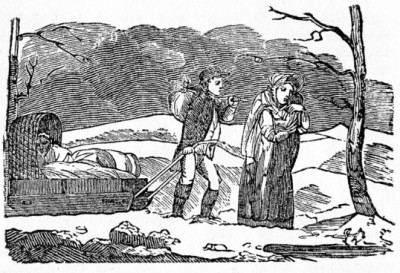The Germans called it “The Year of the Beggar.”
The New Englanders called it “Eighteen Hundred and Froze to Death.”
From his home in Monticello, Thomas Jefferson wrote, “Never were such hard times.”
Writer Mary Shelley described a June outing that year to Lake Geneva this way: “An almost perpetual rain confines us principally to the house.” She ended up using some of the descriptions of that dreary summer in her novel Frankenstein.
It was the year 1816, often called “The Year Without a Summer,” and it just might be the most important meteorological event you have never heard of. Spring arrived on time, but then the weather went into reverse, with cold temperatures and continually overcast skies. Dim sunlight and frigid temperatures became so severe and widespread that major crop failures were reported across the United States, the rest of North America and Europe for a period of three years. New York state and Maine experienced snow in June.
While some scientists blamed sunspots for the weather problems of 1816, and some theologians blamed the wrath of God, it has only been within the last few decades that modern technology has enabled us to understand what really happened. And the implications are significant for our world today.
Emergency Survival Seed Bank Provides THOUSANDS Of Pounds Of Food
Scientists now believe that this three-year period of severe climate change was set off by a volcanic eruption. On April 15, 1815, Mount Tambora on the island of Sumbawa in what is now Indonesia erupted, spewing lava and dust for a week and then continuing to rumble for three months.
With a plume of gases and ash that extended more than 18 miles into the atmosphere, the massive Mount Tambora eruption is the most explosive volcanic event in recorded history. The 1815 eruption threw millions of tons of sulfur-dioxide gas into the stratosphere, and the gas then formed 100 million tons of sulfuric acid, which became dispersed by wind throughout the planet in the form of tiny droplets, clouding the skies and partially blocking the sun.
The Tambora explosion was far greater than the better-known Mount Krakatoa volcanic eruption in 1883. We know more about that natural disaster because the news was quickly spread by telegraph and then by newspaper. Most Europeans and North Americans did not hear about Mount Tambora for several months or even longer.
The explosion initially killed more than 10,000 people on the island, but it is estimated that another 80,000 people eventually died from starvation and diseases related to the cataclysmic event. In fact, the energy created by Mount Tambora was equivalent to 2.2 million atomic bombs.
The volcanic dust and ash that spread throughout the world blocked sunlight and disrupted natural weather patterns.
The Easiest Way To Store A Month’s Worth Of Emergency Food!
What are some of the far-reaching results of the ravaged weather of 1816?
- Many New England farmers, with their crops and their entire livelihood devastated, ventured west with their families. The state of Vermont, for example, experienced a population drop of an estimated 10,000 to 15,000 people.
- The cold, rainy summer led to a sweeping potato famine in Ireland.
- In Europe, the wheat crop was ruined, causing widespread bread shortages.
- Food prices rose sharply across Europe, with riots, arson and looting frequently taking place.
- In Switzerland, an ice dam formed below part of the Giétro Glacier. Despite efforts to drain the lake that formed, the ice dam collapsed in June 1818, killing an estimated 45 people.
- In Asia, unseasonably cold temperatures killed rice crops, trees and water buffalo. The eruption disrupted China’s monsoon season, resulting in severe flooding in the Yangtze Valley. In India, the summer monsoon season was delayed, resulting in late torrential rains.
- Outbreaks of cholera spread from a region near the River Ganges to as far away as Moscow.
- Because of all the volcanic ash in the atmosphere, brown snow fell in Hungary. Red snow fell throughout the year in Italy’s northern and north-central region.
Floods, drought, disease, famine – all caused by a volcanic eruption half a world away. With the world’s population so much greater than it was in 1816, the effects of another eruption on the scale of Mount Tambora would be unthinkable.
Today, the year 1816 stands as a startling reminder of how one world event — even a volcano in Southeast Asia — can have dire consequences on our food supply.
Poet Eileen Marguet (1918-2012) wrote a poem that sums up the year of 1816 for many Americans.
It didn’t matter whether your farm was large or small.
It didn’t matter if you had a farm at all.
Cause everyone was affected when water didn’t run.
The snow and frost continued without the warming sun.
One day in June it got real hot and leaves began to show.
But after that it snowed again and wind and cold did blow.
The cows and horses had no grass, no grain to feed the chicks.
No hay to put aside that time, just dry and shriveled sticks.
The sheep were cold and hungry and many starved to death,
Still waiting for the warming sun to save their labored breath.
The kids were disappointed, no swimming, such a shame.
It was in 1816 that summer never came.
Do you believe America is ready for another such natural disaster? Share your thoughts in the section below:
Discover The Secret To Saving Thousands At The Grocery Store. Read More Here.
